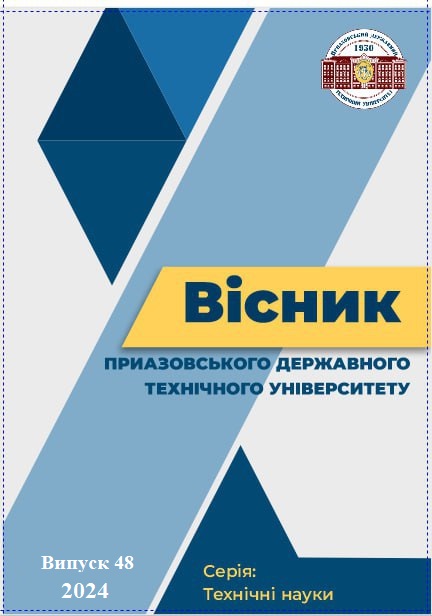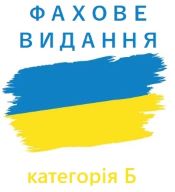Удосконалення моделі для розрахунку коефіцієнта захисту фільтрувального респіратора від шкідливого аерозолю
DOI:
https://doi.org/10.31498/2225-6733.48.2024.310702Ключові слова:
математична розрахункова модель, коефіцієнт захисту, фільтрувальна півмаска, дихання людини, осадження часток, відбирання пробиАнотація
Мета дослідження. Удосконалення моделі для розрахунку коефіцієнта захисту фільтрувальних респіраторів від шкідливого твердого аерозолю. Матеріали і методи. Для експериментального визначення коефіцієнта захисту фільтрувального респіратора відповідно до стандарту ДСТУ EN 149:2017 «Засоби індивідуального захисту органів дихання. Півмаски фільтрувальні для захисту від аерозолів. Вимоги, випробування, маркування» та застосовування методу ДСТУ EN 13274-1:2005 «Засоби індивідуального захисту органів дихання. Методи випробування. Частина 1. Визначення коефіцієнта проникання і загального коефіцієнту проникання», використали на добровольцях легкі фільтрувальні півмаски для захисту від аерозолів типу «Стандарт» FFP2. Результати. Обчислено коефіцієнт захисту фільтрувальних респіраторів, що використовувались на добровольцях у лабораторних умовах при визначеній концентрації тест-аерозолю в навколишньому середовищі за стандартним методом випробуавнь, який описаний у ДСТУ EN 13274-1:2005 «Засоби індивідуального захисту органів дихання. Методи випробування. Частина 1. Визначення коефіцієнта проникання і загального коефіцієнту проникання» і передбачає врахування похибки вимірювання від приладів не більше 10%. Проведено порівняння отриманих показників коефіцієнта захисту фільтрувальних респіраторів у лабораторних умовах і за розробленою теоретичною моделлю з урахуванням осадження частинок у пробоотбірному зонді та підмасковому просторі півмаски під час процесу видихання, що показало гарний збіг показників за t-критерієм Стюдента. Наукова новизна. Наукова новизна полягає у розробці моделі для розрахунку коефіцієнта захисту фільтрувальних респіраторів на основі оцінюваної масової функції розподілу аерозольних частинов в зоні дихання; функції проникнення через зазор між обличчям і півмаскою з урахуванням процесу вдихання і видихання, а також осадження частинок у пробовідбірному зонді. Практичне значення роботи полягає у розробці формули щодо теоретичного визначення коефіцієнта захисту фільтрувальних респіраторів, яка використовується для розрахунку професійного ризику захворювання користувачів на пневмоконіоз
Посилання
World Health Statistics 2023. Офіційний сайт INCUBATOR – Global healht education and learning at Havard University. URL: https://repository.gheli.harvard.edu/repository/11008/ (дата звернення: 15.06.2023).
Analysis of the research subjects and hot topics of occupational diseases through the Web of Science from 1975 to 2021 / H. R. Saberi, H. Rabiei, A. Zare, M. D. Jazari, M. Malakoutikhah. Frontiers in Public Health. 2022. Vol. 10. Pp. 1-15. DOI: https://doi.org/10.3389/fpubh.2022.1009203.
Qi, X.M., Luo, Y., Song, M.Y., Liu, Y., Shu, T., Liu, Y., Pang, J.L., Wang, J., & Wang, C. Pneumoconiosis: current status and future prospects. Chinese Medical Journal. 2021. Vol. 134. Iss. 8. Pp. 898-907. DOI: https://doi.org/10.1097/CM9.0000000000001461.
Dabbicco G., Mattei G. The reconciliation of budgeting with financial reporting: A comparative study of Italy and the UK. Public Money & Management. 2021. Vol. 41. Iss. 2. Pp. 127-137. DOI: https://doi.org/10.1080/09540962.2019.1708059.
Alkhyyoon H., Abbaszadeh M. R., Zadeh F. N. Organizational risk management and performance from the perspective of fraud: a comparative study in Iraq, Iran, and Saudi Arabia. Journal of Risk and Financial Management. 2023. Vol. 16(3). Pp. 1-27. DOI: https://doi.org/10.3390/jrfm16030205.
Development and internal validation of risk assessment models for chronic obstructive pulmonary disease in coal workers / H. Wang et al. International Journal of Environmental Research and Public Health. 2023. Vol. 20(4). Pp. 1-20. DOI: https://doi.org/10.3390/ijerph20043655.
Respirable coal mine dust: a review of respiratory deposition, regulations, and characterization / Y. Shekarian et al. Minerals. 2021. Vol. 11(7). Pp. 1-25. DOI: https://doi.org/10.3390/min11070696.
Paul R., Adeyemi O., Arif A. A. Estimating mortality from coal workers' pneumoconiosis among Medicare beneficiaries with pneumoconiosis using binary regressions for spatially sparse data. American Journal of Industrial Medicine. 2022. Vol. 65(4). Pp. 262-267. DOI: https://doi.org/10.1002/ajim.23330.
Clinical statistics analysis on the characteristics of pneumoconiosis of Chinese miner population / M.F. Wang et al. Journal of Thoracic Disease. 2016. Vol. 8(8). Pp. 2203-2211. DOI: https://doi.org/10.21037/jtd.2016.07.53.
Prediction of aerosol deposition in the human respiratory tract via computational models: a review with recent updates / V. K. H. Bui et al. Atmosphere. 2020. Vol. 11(2). Pp. 1-27. DOI: https://doi.org/10.3390/atmos11020137.
Laney A. S., Weissman D. N. Respiratory diseases caused by coal mine dust. Journal of Occupational and Environmental Medicine. 2014. Vol. 56. Pp. 518-522. DOI: https://doi.org/10.1097/JOM.0000000000000260.
Kleinstreuer C., Zhang Z. Airflow and particle transport in the human respiratory system. Annual reviews. 2010. Vol. 42. Pp. 301-334. DOI: https://doi.org/10.1146/annurev-fluid-121108-145453.
Physico-chemical properties and reactive oxygen species generation by respirable coal dust: Implication for human health risk assessment / M. A. Zazouli et al. 2021. Journal of Hazardous Materials. Vol. 405. 124185. DOI: https://doi.org/10.1016/j.jhazmat.2020.124185.
Sarver E., Keleş Ç., Afrouz S. G. Particle size and mineralogy distributions in respirable dust samples from 25 US underground coal mines. International Journal of Coal Geology. 2021. Vol. 247. 103851. DOI: https://doi.org/10.1016/j.coal.2021.103851.
Review of respirable coal mine dust characterization for mass concentration, size distribution and chemical composition / B. Abbasi et al. Minerals. 2021. Vol. 11(4). Pp. 1-36. DOI: https://doi.org/10.3390/min11040426.
A systematic review of occupational exposure to coal dust and the risk of interstitial lung diseases / C. Beer et al. European Clinical Respiratory Journal. 2017. Vol. 4. Iss. 1. Pp. 1-11. DOI: https://doi.org/10.1080/20018525.2017.1264711.
Chemistry and particle size distribution of respirable coal dust in underground mines in Central Eastern Europe / P. Trechera et al. International Journal of Coal Science & Technology. 2022. Vol. 9. Pp. 1-17. DOI: https://doi.org/10.1007/s40789-022-00468-2.
Convergence analysis of a fully discrete finite difference scheme for the Cahn-Hilliard-Hele-Shaw equation / Chen W., Liu Y., Wang C., Wise S. M. Mathematics of Computation. 2016. Vol. 85. № 301. Pp. 2231-2257. DOI: https://doi.org/10.1090/mcom3052.
Nonlinear stability of the implicit-explicit methods for the Allen-Cahn equation / Feng X., Song H., Tang T., Yang J. Inverse Problems and Imaging. 2013. Vol. 7. № 3. Pp. 679-695. DOI: https://doi.org/10.3934/ipi.2013.7.679.
Convergence analysis and error estimates for a second order accurate finite element method for the Cahn–Hilliard–Navier–Stokes system / Diegel A. E., Wang C., Wang X., Wise S. M. Numerische Mathematik. 2017. Vol. 137. Pp. 495-534. DOI: https://doi.org/10.1007/s00211-017-0887-5.
Research on regularitiesof cyclic air motion through a respirator filter / O. Bazaluk et al. Applied Sciences. 2021. Vol. 11(7). Pp. 1-15. DOI: https://doi.org/10.3390/app11073157.
Cornejo P., Guerrero N., Sandoval V. Aerodynamic dispersion of respiratory droplets and aerosols by turbulent airflow. Fluids. 2021. Vol. 6(3). Pp. 1-14. DOI: https://doi.org/10.3390/fluids6030119.
Perić R., Perić M. Analytical and Numerical Investigation of the Airflow in Face Masks used for Protection against COVID-19 Virus – Implications for Mask Design and Usage. Journal of Applied Fluid Mechanics. 2020. Vol. 13(6). Pp. 1911-1923. DOI: https://doi.org/10.47176/jafm.13.06.31812.
Development of a dust respirator by improving the half mask frame design / O. Bazaluk et al. International Journal of Environmental Research and Public Health. 2021. Vol. 18. Pp. 1-12. DOI: https://doi.org/10.3390/ijerph18105482.
Automated air pressure control system in a motorised breathing apparatus / D. Slavinskyi et al. Machinery & Energetics. 2024. Vol. 15(1). Pp. 9-22. DOI: https://doi.org/10.31548/machinery/1.2024.09.
Tu J., Yeoh G.-H., Liu C. Chapter 3 – Governing Equations for CFD-Fundamentals. Computational Fluid Dynamics. A Practical Approach. 2-nd ed. 2013. Pp. 61-121. DOI: https://doi.org/10.1016/B978-0-08-098243-4.00003-2.
Burdon Test – Landolt Rings Online. Interactive Portal-Book of Methods of Self-Development. URL: https://metodorf.com/tests/bourdon/bourdonlandolt.php#google_vignette (дата звернення: 20.09.2023).
Aerosol and surface stability of SARS-CoV-2 as compared with SARS-CoV-1 / N. Neeltje van Doremalen et al. The New England journal of Medicine. 2020. Vol. 382. № 16. Pp. 1564-1567. DOI: https://doi.org/10.1056/NEJMc2004973.
Bourouiba L., Dehandschoewercker E., Bush J. W. M. Violent expiratory events: on coughing and sneezing. Journal of Fluid Mechanics. 2014. Vol. 745. Pp. 537-563. DOI: https://doi.org/10.1017/jfm.2014.88.
How far droplets can move in indoor environments-revisiting the Wells evaporation-falling curve / X. Xie et al. Indoor air. 2007. Vol. 17(3). Pp. 211-225. DOI: https://doi.org/10.1111/j.1600-0668.2007.00469.x.
Sun C., Zhai Z. The efficacy of social distance and ventilation effectiveness in preventing COVID-19 transmission. Sustainable Cities and Society. 2020. Vol. 62. Pp. 1-10. DOI: https://doi.org/10.1016/j.scs.2020.102390.
Increasing the insulation properties of filter respirators to protect miners’ respiratory organs from dust / S. Cheberiachko et al. Rudarsko-geološko-Naftni Zbornik. 2023. Vol. 38(4). Pp. 27-40. DOI: https://doi.org/10.17794/rgn.2023.4.3.
Development of an algorithm for effective design of respirator half-masks and encapsulated particle filters / Cheberyachko S., Cheberyachko Y., Naumov M., Deryugin O. International Journal of Occupational Safety and Ergonomics. 2022. Vol. 28(2). Pp. 1145-1159. DOI: https://doi.org/10.1080/10803548.2020.1869429.
Han Y., Hu Y., Qian F. Effects of air temperature and humidity on particle deposition. Chemical Engineering Research and Design. 2011. Vol. 89(10). Pp. 2063-2069. DOI: https://doi.org/10.1016/j.cherd.2011.02.001.
Effects of Ambient Temperature and Humidity on Natural Deposition Characteristics of Air-borne Biomass Particles / Yuan Y., Li S., Chen T., Ren J. International Journal of Environmental Research and Public Health. 2023. Vol. 20(3). Pp. 1-14. DOI: https://doi.org/10.3390/ijerph20031890.
Sustainable concrete: Building a greener future / L. Assi et al. Journal of Cleaner Production. 2018. Vol. 198. Pp. 1641-1651. DOI: https://doi.org/10.1016/j.jclepro.2018.07.123.
Shao Y. Adhesion theory and model for air humidity impact on dust emission. Aeolian Re-search. 2024. Vol. 66. 100898. DOI: https://doi.org/10.1016/j.aeolia.2024.100898.
Gábor B., Gábor K. Data Analysis for Business, Economics, and Policy. Cambridge: Cambridge University Press, 2021. 730 p. URL: https://www.cambridge.org/highereducation/books/data-analysis-for-business-economics-and-policy/D67A1B0B56176D6D6A92E27F3F82AA20#overview.
Fukunishi A., Mori Y. Adhesion force between particles and substrate in a humid atmosphere studied by atomic force microscopy. Advanced Powder Technology. 2006. Vol. 17. Iss. 5. Pp. 567-580. DOI: https://doi.org/10.1163/156855206778440552.
Busnaina A. A., Elsawy T. The Effect of Relative Humidity on Particle Adhesion and Removal. The Journal of Adhesion. 2000. Vol. 74. Iss. 1-4. Pp. 391-409. https://doi.org/10.1080/00218460008034538.
##submission.downloads##
Опубліковано
Як цитувати
Номер
Розділ
Ліцензія
Журнал "Вісник Приазовського державного технічного університету. Серія: Технічні науки" видається під ліцензією СС-BY (Ліцензія «Із зазначенням авторства»).
Дана ліцензія дозволяє поширювати, редагувати, поправляти і брати твір за основу для похідних навіть на комерційній основі із зазначенням авторства. Це найзручніша з усіх пропонованих ліцензій. Рекомендується для максимального поширення і використання неліцензійних матеріалів.
Автори, які публікуються в цьому журналі, погоджуються з наступними умовами:
1. Автори залишають за собою право на авторство своєї роботи та передають журналу право першої публікації цієї роботи на умовах ліцензії Creative Commons Attribution License, яка дозволяє іншим особам вільно розповсюджувати опубліковану роботу з обов'язковим посиланням на авторів оригінальної роботи та першу публікацію роботи в цьому журналі.
2. Автори мають право укладати самостійні додаткові угоди, які стосуються неексклюзивного поширення роботи в тому вигляді, в якому вона була опублікована цим журналом (наприклад, розміщувати роботу в електронному сховищі установи або публікувати у складі монографії), за умови збереження посилання на першу публікацію роботи в цьому журналі.









